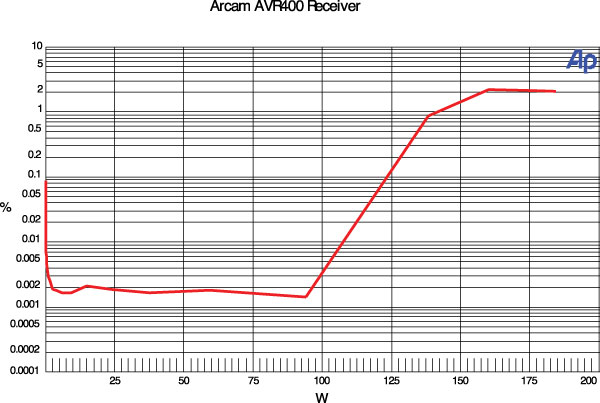Arcam AVR400 A/V Receiver HT Labs Measures
Five channels driven continuously into 8-ohm loads:
0.1% distortion at 84.4 watts
1% distortion at 102.8 watts
Seven channels driven continuously into 8-ohm loads:
0.1% distortion at 74.4 watts
1% distortion at 83.3 watts
Analog frequency response in Stereo Direct mode:
–0.06 dB at 10 Hz
–0.01 dB at 20 Hz
–0.07 dB at 20 kHz
–2.79 dB at 50 kHz
Analog frequency response with stereo signal processing:
–1.55 dB at 10 Hz
–0.47 dB at 20 Hz
–0.22 dB at 20 kHz
–13.52 dB at 50 kHz

This graph shows that the AVR400’s left channel, from CD input to speaker output with two channels driving 8-ohm loads, reaches 0.1 percent distortion at 123.3 watts and 1 percent distortion at 141.6 watts. Into 4 ohms, the amplifier reaches 0.1 percent distortion at 161.7 watts and 1 percent distortion at 199.6 watts.
Response from the multichannel input to the speaker output measures –0.06 dB at 10 Hz, –0.01 dB at 20 Hz, –0.07 dB at 20 kHz, and –2.85 dB at 50 kHz. THD+N from the CD input to the speaker output was less than 0.003 percent at 1 kilohertz when driving 2.83 volts into an 8-ohm load. Crosstalk at 1 kHz driving 2.83 volts into an 8-ohm load was –84.24 decibels left to right and –81.22 dB right to left. The signal-to-noise ratio with an 8-ohm load from 10 hertz to 24 kHz with “A” weighting was –110.74 dBrA.
From the Dolby Digital input to the loudspeaker output, the left channel measures –0.00 dB at 20 Hz and –0.13 dB at 20 kHz. The center channel measures –0.01 dB at 20 Hz and –0.18 dB at 20 kHz, and the left surround channel measures –0.01 dB at 20 Hz and –0.17 dB at 20 kHz. From the Dolby Digital input to the line-level output, the LFE channel is +0.04 dB at 20 Hz when referenced to the level at 40 Hz and reaches the upper 3-dB down point at 109 Hz and the upper 6-dB down point at 116 Hz.—MJP
Video Test Bench
The Arcam’s video processing was below average in both the analog and digital tests. The failures shown here should not be as intrusive on normal program material as in our bench tests (which are designed to trip up video processors that are less than pristine). Nevertheless, we recommend, if possible, that you use the video circuits in this A/V receiver in passthrough mode, where it performs well, and do any desired upconversion or other video processing in either the source or the display.—TJN

- Log in or register to post comments






























































